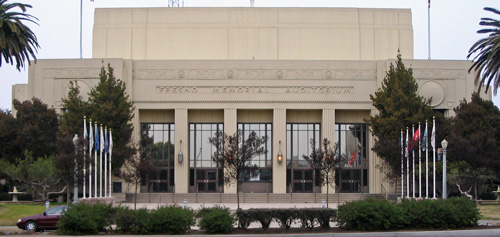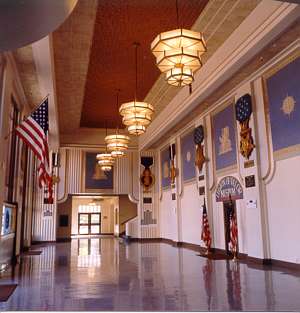
Fresno Memorial Auditorium (1936)
2425 Fresno Street
Allied Architects of Fresno, Architects
Monumental Moderne with Art Deco details
Description
The Fresno Memorial Auditorium is located in downtown Fresno on a full city block bounded by Fresno, N, O, and Merced Streets. The auditorium was constructed in 1935-1936, and was dedicated on December 31, 1936.
The structure includes a partial basement, a main or ground floor, a mezzanine or second floor, and a third floor. The overall dimensions are 170' x 236'. There are three main parts to the structure, including the foyer, auditorium and the stage. The original auditorium could accommodate 2,000 people with portable seats on the main floor and seating of an additional 1,500 permanent seats on the balcony. Ancillary rooms provided space for meeting rooms, ticket booths, coat check, dressing rooms and storage. The foyer is a grand space with a 26-foot ceiling and five double door entrances surmounted by 14-foot high windows. The foyer walls and ceiling are decorated with Art Deco murals by Anthony Heinsbergen. The stage area is 39' x 75' with a loft height of 64 feet. The building consists of a steel frame with concrete walls and floors, including the cantilevered balcony.

The exterior is predominantly an arrangement of various plane surfaces with a minimum of detailed elements. A bas-relief band and the name of building above the entrance were made of poured-in-place concrete. The doors and front windows are wood framed, while other windows are steel casement type. The front entry doors are divided by rectangular columns, with fluted facing. Among the major Art Deco elements are the large bronze light fixtures mounted on the columns. There are three additional entrances on each side. The middle of the three entrances are intact, but are not used. Their interior entryways have been converted to office space.
The original interior of the auditorium contained few decorative elements. The wood door frames were milled with grooves similar to the fluted exterior columns. The ticket booth windows were trimmed with black marble. The restrooms have marble walls and one-ince hexagonal tile flooring. The building contains the original light fixtures in the foyer and corridors, and back-lit room identification signs with Art Deco lettering.
The completion in 1966 of a new convention center complex led to several changes in the Memorial Auditorium. The most significant change was the creation, within the main auditorium, of a 500-seat theater with a sloped floor and improved acoustics. The theater occupies about two-thirds of the original auditorium; the rest of the auditorium is used for rehearsal activities. Most of the meeting rooms have been converted to offices, which for many years housed various city administrative functions.
The auditorium has had several minor changes to its exterior, which have occurred incrementally over a long period. The entrance doors were originally wood with large glass panels. They have been replaced by anodized aluminum doors with glass panels. The wood door frames remain. The new doors are painted the same color as the originals, so that the change of materials is not noticeable. The central entrance on the west facade was changed by the addition of a canopy to shade the landing and doors from the afternoon sun. The addition was very simple and does not alter the original character of the building.
A more significant addition to the structure was the placing of a Civil Defense siren and several antennae on the roof. The Civil Defense siren, added in 1960, is small and centered near the front of the building. Three antennae are located at the rear of the stage loft roof. The largest is a triangular truss-style structure, approximately fifty feet tall. Three single poles add about ten feet to the tower's height. A microwave dish, eight feet in diameter, is mounted at the base of the large antenna. The smaller antennae are single pole structures about ten feet in height. The antennae as a group have a minimal impact on the overall structure, due to their size in comparison to the main building and their commonness in the area.
Historical significance
The Fresno Memorial Auditorium was, from 1936 to 1966, Fresno's most significant cultural facility. All of the individuals connected with its design and construction were notable architects, engineers, artists and contractors. The building's Art Deco exterior was outstanding for its time, and is unchanged from its original construction. The building has additional significance because of the many political and entertainment personalities who have appeared before its audiences.
Events held in the auditorium include Broadway plays and musicals, concerts, operas, ballet performances, high school graduations, dances, circuses, fashion shows, fraternal conventions, auto shows, athletic events, religious rallies, and political conventions. The 1956 California Democratic Convention took place there, with presidential and vice-presidential candidates Adlai Stevenson and Estes Kefauver attending.
Performers in the auditorium have included Jose Iturbi, Eddie Cantor, Frank Sinatra, Ricky Nelson, the Platters, Ray Charles, Lloyd Nolan, Jose Greco, Henry Fonda, Tallulah Bankhead, Sonny and Cher, Gene Krupa, Fats Domino, and Fred Waring's Pennsylvanians.
Local groups that have used the auditorium on a regular basis include the Fresno Philharmonic Orchestra, Fresno Community Theater, Fresno Children's Playhouse, Fresno Civic Opera, Fresno Community Chorus, Fresno Dance Reptertory Group, and Cultural Arts for You classes. The Cultural Arts for You, a division of the City's Parks and Recreation Department, had offices in the auditorium and also was responsible for its management for most of the period from 1967 to 1992.
The Patrons for Cultural Arts was formed in 1983 to provide a non-profit sponsor for the Cultural Arts program and also to provide resources for maintenance and improvement of the auditorium facilities.
In 1992 an association of American war veterans organizations requested that the City rename the building to Veterans Memorial Auditorium and allow them to use office space that was vacated when the City's data processing division moved into the new City Hall. The veterans also established the National Legion of Valor Museum in the auditorium. It contains an outstanding collection of military memorabilia, and pays special tribute to personnel receiving the four highest military honors--the Medal of Honor, the Distinguished Service Cross, the Navy Cross, and the Air Force Cross.
Adapted from the National Register of Historic Places nomination, original prepared by Roger Bordeaux Taylor.